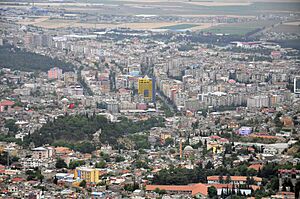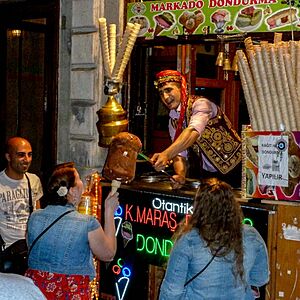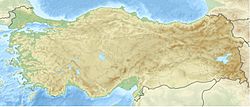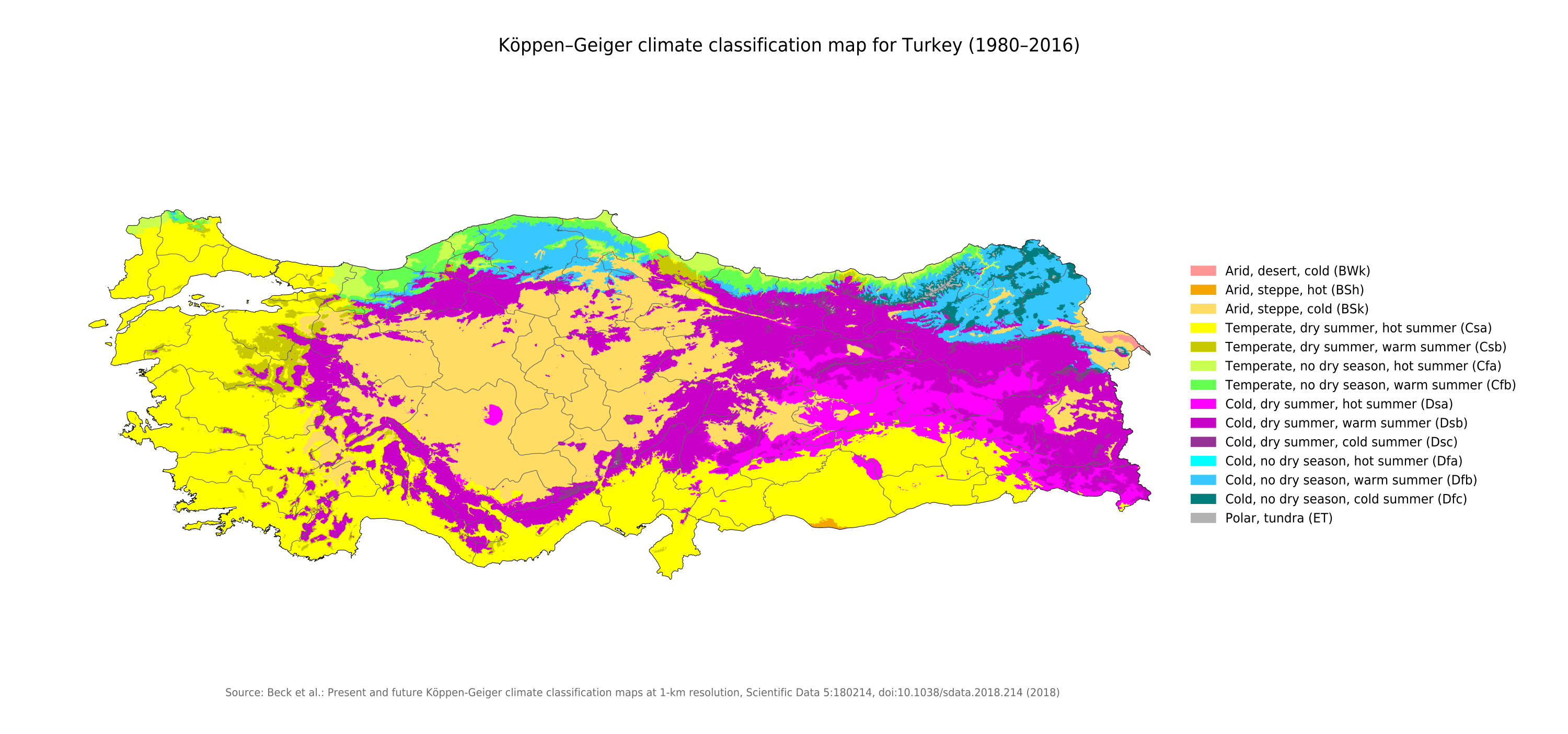Kahramanmaraş facts for kids
Quick facts for kids
Kahramanmaraş
|
||
|---|---|---|
|
Metropolitan municipality
|
||

A view of the city center
|
||
|
||
| Country | Turkey | |
| Region | Mediterranean | |
| Province | Kahramanmaraş | |
| Elevation | 568 m (1,864 ft) | |
| Population
(2022)
|
||
| • Urban | 571,266 | |
| Time zone | UTC+3 (TRT) | |
| Area code(s) | 0344 | |
| Licence plate | 46 | |
Kahramanmaraş is a city in the Mediterranean region of Turkey. It is the main city and administrative center of Kahramanmaraş province.
The city was historically known as Marash and Germanicea. In 1973, its name officially became Kahramanmaraş. The word kahraman means "heroic" in Turkish. This name was added to honor the city's brave resistance during the Battle of Marash. Kahramanmaraş is located on a flat area at the base of Mount Ahır.
In February 2023, a very strong earthquake hit the region. The earthquake's center was in Pazarcık and Elbistan, both in Kahramanmaraş province. Much of the city was sadly damaged or destroyed.
Contents
Geography and Climate
The city center of Kahramanmaraş is about 568 meters (1,864 feet) above sea level. The Ceyhan River is an important river in the area. It starts in the mountains near the Elbistan Plain.
Weather in Kahramanmaraş
Kahramanmaraş has a Mediterranean climate. This means it has hot, dry summers and cool, wet winters. However, it also gets some continental influences from the northern areas.
Summers are very hot and dry. The average daytime temperature is around 35°C (95°F). Temperatures can easily reach 40°C (104°F) or even higher. The hottest temperature ever recorded was 47.2°C (117°F) in August 2023.
Winters are cool and wet. Daytime temperatures are usually between 5°C and 10°C (41-50°F). The coldest temperature ever recorded was -9.6°C (15°F) in February 1997.
| Climate data for Kahramanmaraş (1991–2020, extremes 1930–2023) | |||||||||||||
|---|---|---|---|---|---|---|---|---|---|---|---|---|---|
| Month | Jan | Feb | Mar | Apr | May | Jun | Jul | Aug | Sep | Oct | Nov | Dec | Year |
| Record high °C (°F) | 18.7 (65.7) |
25.3 (77.5) |
29.8 (85.6) |
36.0 (96.8) |
39.3 (102.7) |
42.0 (107.6) |
45.2 (113.4) |
47.2 (117.0) |
42.5 (108.5) |
38.6 (101.5) |
29.6 (85.3) |
24.0 (75.2) |
47.2 (117.0) |
| Mean daily maximum °C (°F) | 9.5 (49.1) |
11.6 (52.9) |
16.5 (61.7) |
21.8 (71.2) |
27.4 (81.3) |
32.8 (91.0) |
36.5 (97.7) |
36.9 (98.4) |
33.1 (91.6) |
26.6 (79.9) |
17.8 (64.0) |
11.3 (52.3) |
23.5 (74.3) |
| Daily mean °C (°F) | 5.2 (41.4) |
6.7 (44.1) |
11.0 (51.8) |
15.6 (60.1) |
20.6 (69.1) |
25.7 (78.3) |
28.9 (84.0) |
29.2 (84.6) |
25.6 (78.1) |
19.6 (67.3) |
11.8 (53.2) |
6.9 (44.4) |
17.2 (63.0) |
| Mean daily minimum °C (°F) | 1.9 (35.4) |
2.7 (36.9) |
6.3 (43.3) |
10.3 (50.5) |
14.8 (58.6) |
19.5 (67.1) |
22.8 (73.0) |
23.0 (73.4) |
19.2 (66.6) |
13.8 (56.8) |
7.4 (45.3) |
3.6 (38.5) |
12.1 (53.8) |
| Record low °C (°F) | −9.0 (15.8) |
−9.6 (14.7) |
−7.6 (18.3) |
−1.8 (28.8) |
4.7 (40.5) |
6.6 (43.9) |
12.4 (54.3) |
12.5 (54.5) |
4.0 (39.2) |
0.0 (32.0) |
−4.4 (24.1) |
−7.6 (18.3) |
−9.6 (14.7) |
| Average precipitation mm (inches) | 130.2 (5.13) |
118.0 (4.65) |
95.8 (3.77) |
74.6 (2.94) |
42.7 (1.68) |
6.8 (0.27) |
2.4 (0.09) |
1.9 (0.07) |
17.3 (0.68) |
45.3 (1.78) |
89.5 (3.52) |
126.4 (4.98) |
750.9 (29.56) |
| Average precipitation days | 10.77 | 10.07 | 9.90 | 9.73 | 7.23 | 2.10 | 0.50 | 0.77 | 2.47 | 6.40 | 7.20 | 9.23 | 76.4 |
| Average snowy days | 2.6 | 0.8 | 0.3 | 0 | 0 | 0 | 0 | 0 | 0 | 0 | 0 | 0.1 | 3.8 |
| Average relative humidity (%) | 70.1 | 65.5 | 59.3 | 57.4 | 54.6 | 49.6 | 50.3 | 51.5 | 49.3 | 54.4 | 63.1 | 71.0 | 58.0 |
| Mean monthly sunshine hours | 102.3 | 115.8 | 164.3 | 195.0 | 248.0 | 297.0 | 319.3 | 297.6 | 252.0 | 198.4 | 135.0 | 99.2 | 2,423.9 |
| Mean daily sunshine hours | 3.3 | 4.1 | 5.3 | 6.5 | 8.0 | 9.9 | 10.3 | 9.6 | 8.4 | 6.4 | 4.5 | 3.2 | 6.6 |
| Source 1: Turkish State Meteorological Service | |||||||||||||
| Source 2: NOAA (humidity, 1991–2020), Meteomanz(snow days 2017-2023) | |||||||||||||
History of Kahramanmaraş
Ancient Times
In the early Iron Age, around 1100 BC, the city of Maraş was the capital of a state called Gurgum. People living there called it "the Kurkumaean city." The Assyrians, another ancient group, knew it as Marqas. Around 711 BC, the Assyrians took over Gurgum and renamed it Marqas after its capital city.
Later, during the Roman and Byzantine times, Maraş was known as Germanicia Caesarea. This name likely came from Germanicus Julius Caesar, a famous Roman general. In 2010, the first ancient ruins of Germanicia were found in the city.
Medieval Period
During the Byzantine Empire, Germanikeia was an important religious center. It was taken by Arab forces in the 7th century. Later, in the 11th century, after Armenian kingdoms fell, the city became a strong base for Armenians. It was even the capital of a short-lived Armenian principality.
In 1100, the city was captured by the Danishmends, then by the Seljuks in 1103. Crusaders, led by Tancred, took it back in 1107 with help from Toros I of Cilician Armenia. The city suffered a big earthquake in 1114, which caused much destruction.
Over the next centuries, the city changed hands many times between different groups. These included the Seljuks, the Armenian Kingdom of Cilicia, and the Mamluks. From 1337 to 1515, the Dulkadirs ruled Marash as allies of the Mamluks. Then, it became part of the Ottoman Empire.
Modern History
Under Ottoman rule, Marash was an important administrative center. During World War I, there were conflicts in the region. In 1915, some Armenian groups from Marash villages fought against the Ottoman army.
After World War I, British troops controlled Marash for a short time. Then, French troops took over in October 1919.
The Battle of Marash
The French occupation led to strong resistance from the Turkish people. A Turkish leader named Dr. Mustafa organized groups to fight back. An incident where a French soldier disrespected a local woman sparked public anger. This led to the first shots being fired against the French forces.
Turkish groups secretly organized to resist the French. They formed a committee and divided their forces into small, secret groups. They gathered weapons, some old hunting rifles, and even took rifles from fallen French soldiers.
On January 20, 1920, the Turkish rebellion began suddenly. Turkish fighters attacked French soldiers and took control of important locations. The French responded with heavy shelling, but the Turkish rebels fought bravely.
A telegram sent to the French Commander by local elders stated that the French forces, especially those with Armenian soldiers, were showing hatred towards Muslims. This caused more tension.
On February 8, a sad event occurred during the battle. Many Christian civilians lost their lives. Some found shelter in churches and schools, but these buildings were set on fire.
The French secretly decided to leave the city. On February 12, the Turkish National Movement won the battle without outside help. This victory was very important in the Turkish War of Independence. The district of Onikişubat in Marash is named after this date.
After the war, the Treaty of Lausanne was signed, and Marash became part of the new Turkish Republic. In 1925, Marash was honored with a Turkish Medal of Independence for its bravery. In 1973, the Turkish government officially changed the city's name to Kahramanmaraş, adding "Kahraman" (heroic) to remember its resistance.
Recent Events
In December 1978, there was a period of unrest in the city. This event was important in the Turkish government's decision to declare martial law.
In February 2023, a very strong 7.8 magnitude earthquake hit near Kahramanmaraş. It caused widespread damage and sadly, many lives were lost. The city center was hit the hardest, with many homes destroyed. About 17% of the city was damaged.
Population of Kahramanmaraş
| Year | Population |
|---|---|
| 1525–6 | 7,500 |
| 1564–5 | 13,500 |
| 1914 | 32,700 |
| 1927 | 25,672 |
| 1940 | 27,744 |
| 1945 | 33,104 |
| 1950 | 34,641 |
| 1960 | 54,447 |
| 1970 | 110,761 |
| 1980 | 178,557 |
| 2009 | 399,783 |
| 2013 | 458,860 |
| 2017 | 513,582 |
| 2021 | 559,873 |
In the early 1900s, Marash was home to both Armenians and Turks. One estimate from 1913 suggested there were about 45,000 Turks and 30,000 Armenians living in the city.
During World War I and the Turkish War of Independence, the population changed a lot due to conflicts and people moving away. For example, in 1915, some villages around Marash saw fighting between Armenian and Turkish groups.
When the French army occupied Marash during the Turkish War of Independence, some Armenians returned to the city. However, after the Turkish nationalist forces took control in February 1920, there were more conflicts.
Today, Kahramanmaraş is mainly populated by Turkish and Kurdish people. There is also a small Armenian population. As of 2022, the city's population was 571,266. The big earthquake in February 2023 caused many deaths and affected the city's population.
What the City is Known For
Industry and Food
Kahramanmaraş is famous for its delicious ice cream, called dondurma in Turkish. Several well-known ice cream companies, like MADO, started here. Thousands of people visit the city just to try its unique ice cream!

Sports
Near the city, at an elevation of 2,300 meters (7,546 feet), is the Yedikuyular Ski Resort. It's a great place for winter sports like skiing.
Famous People from Kahramanmaraş
- Leo III - A Byzantine emperor who ruled from 717 to 741.
- Nestorius - An important religious leader from the 5th century.
- Gülbahar Hatun - A wife of Sultan Bayezid II and mother of Sultan Selim I of the Ottoman Empire.
- Veysi Kaynak - A Turkish politician who served as a Deputy Prime Minister of Turkey.
- Mahir Ünal - A Turkish politician and academic who was the Minister of Culture and Tourism.
- Ben Bagdikian - An Armenian-American journalist and media critic.
- Emine Hatun - A main wife of Sultan Mehmed I of the Ottoman Empire.
- Serdar Bilgili - A Turkish businessman.
- Soner Sarikabadayi - A Turkish singer.
- Necip Fazıl Kısakürek - A Turkish poet and writer.
- Hasibe Eren - A Turkish actor.
- Şeref Eroğlu - A European and World champion wrestler and Olympic medalist.
- George E. White - An American missionary.
- Necmettin Hacıeminoğlu - A Turkish writer.
Images for kids
See also
 In Spanish: Kahramanmaraş para niños
In Spanish: Kahramanmaraş para niños








